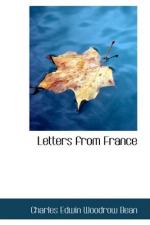We drew up where there was a collection of motor-cars, lorries, and odd riding horses along the roadside, exactly as you might see at the picnic races. We struck inland up one of those glades which the French foresters leave at intervals running from side to side of their well-managed forests. The green moss sank like a soft carpet beneath our feet. The little watergutters bubbled beneath the twigs as we trod across them. The cowslips and anemones nodded as our boots brushed them. Hundreds of birds sang in the branches, and the sunlight came down in shafts from the lacework patches of sky far above, and lit up patches of grass, and fallen leaves, and moss-covered tree trunks, on which sat a crowd chiefly of Australians and New Zealanders. As one of the English correspondents said, “It was just such a forest as Shakespeare wrote about.” Who would have thought that scene believable two years before?
A contest had been arranged between Australasians and Canadians in France to decide which could fell trees in the quickest time. It began really with the French forest authorities, who insisted on the well-known forest rule that no young trees under one metre twenty in girth must be felled after the middle of May, because if you cut the young tree after the sap begins to rise it will not grow again. The British officer in control of the forest had obtained an extension until the end of May, but he had to get felled by then all the young timber that he wanted before September. He had borrowed some Maoris to help, and he noticed how they cut and the sort of sportsmen they were. He was struck with an idea. A French forest officer was with him. “How long do you think it would take a New Zealander to chop down a tree like that?” asked the Frenchman. “A minute,” was the answer. “Unbelievable,” exclaimed the Frenchman. A Maori was called up, and the tree was down in forty seconds.
After that a contest was arranged between Maoris and French wood-cutters. Trees had to be cut in the French style, which, it must be admitted, is much neater and more economical, and about five times as laborious. The trees are cut off at ground level, and so straightly that the stump would not trip you if it were in the middle of the road. Each team consisted of six men, and felled twelve small trees, using its own accustomed axes. The Maoris won by four minutes.
It was out of this that the big contest sprang. The Canadians and Australasians challenged one another. This time the teams were to be of three men. Each team was to cut three trees—only service axes to be used; but otherwise each man could cut in any style he wished. The trees averaged about two feet thick—hard wood. The teams started to practise. And the forest officers’ problem was solved.
The teams tossed for trees, and tossed for the order in which they were to cut. I believe that when some question arose out of this toss, the Maoris immediately offered to toss again, in order to have no advantage from the result.




